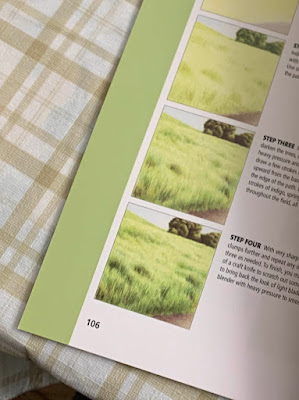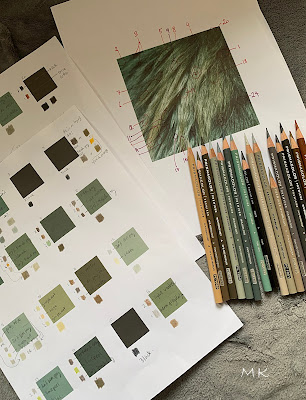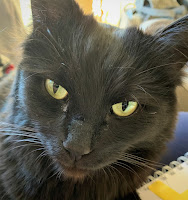Hello! Since it's December and winter is here, I'd like to show you a little painting that reflects the current season. Because I am still very much learning to work with watercolor, I decided to follow a tutorial of a much more experienced artist - Karen Rice. The one I chose is called "An Essential Lesson in Watercolour", and can be accessed on You Tube here. I must say that Karen's instructions were very clear and easy to follow, and I had lots of fun painting along with her. Using watercolors is a little bit like herding water, so everyone's version will look different. Add to that one's choice of paint (Qor), paper ( Canson Montval), a tendency to tweak, and the results can vary dramatically from the original. 😄 Unlike Karen, I decided to skip adding human figures to my painting. Since I had to work rather quickly (before everything dried to a crisp), I did not take any 'in progress' photos. I know that my results are far from perfect, but I still have a certain fondness for the finished picture.
Wishing everyone a wonderful and creative day, and a peaceful Holiday Season.
December 7, 2022
Winter Scene
October 13, 2022
Red Apple in Oil Pastels
Also, FYI, I used Canvy app to present my painting as if it was mounted on a wall, which appears to be much larger in scale than it actually is. In reality, the measurements of the image are only 12x16.5 cm/ 4.75x 6.5".
After the apple was done, it was time to add the background. I decided to layer blue on top of black for added richness and depth. The process was so fast! If I used coloured pencils, it would have taken me many long hours just to build up that kind of smooth, dark, rich background. Here, it took me less than one hour for the dark navy background! I love how easily the Neopastels blended and layered!
And here it is finished, along with some photos of the details.
August 12, 2022
A Girl in a Hoodie
From then on, it was basically a matter of adding and refining details, adjusting the values, which can take up to several weeks, depending on how much detail you want to include and how much time you have.
And so on, until she's finished:
And that's about it. Thank you so much for visiting my blog. Don't forget to do something creative at least once a week - it's' very therapeutic. Wishing everyone a great day.
July 5, 2022
Grass Field - drawing exercise
June 22, 2022
Watercolour pear
Hello! Today, I present a painting of a pear I made some time ago. I always wanted to become better at using watercolours, but found this medium to be too hard to control and unpredictable overall, especially comparing to acrylics. At first, I just tried to get a better understanding of the basics, so I enrolled in a short, yet very effective online course from Michele Webber - "Basic Watercolor Techniques." Afterwards, feeling like I could probably tackle something more complicated, yet not feeling confident in terms of painting something completely original, I decided to try one of Anna Mason's tutorials - The Pear, as I like botanical subject matter and how her paintings turn out. The fact that this tutorial was free and the painting itself did not seem too complicated was an added bonus.
Although Anna provided a comprehensive list of needed materials and paint colours, I just used what I already had available, i.e. my own brushes, Arches Hot Pressed Watercolor paper and Roman Szmal paints.
Because I painted this a while back, and I treated it as a practice painting, I only took one 'in progress' photo of the pear:
And here is the finished painting:
Overall, it definitely wasn't too hard, yet challenging enough for a watercolour beginner to get a satisfying learning and fun experience.
Wishing everyone a nice day. See you in the next post.
April 16, 2022
Portrait of a young boy
Hello! Today I show a portrait of a young lad that I painted last year. Although I used a variety of acrylic paints, I mainly relied on Liquitex Basics and Golden Fluid. Although it's not very large, it took several months to complete, as I took breaks in between stages.
Here is how I built the painting in a nutshell.
After staining the pre-stretched canvas with a diluted sienna, and transferring the main outlines onto the surface, I established the main values using Paynes Gray. Then, I lightly underpainted with orange for under skin and clothing, blue in the background, and violet for under the hair. Afterwards, I began building up the actual colors, starting with the face.
Here are the main colours laid out. From this point on, it's mainly fine tuning the shapes and adding in details.
And here it is about 75% done. At this stage, what's left are adjustments of shapes, colours, values and more glazing.
And that is that. Thank you so much for visiting. Wishing everyone a great day.
March 11, 2022
Drawing Cat Hair Exercise
Hello! Continuing with drawing exercises here - they're great for getting your drawing/painting fix when you don't have time, inspiration or energy for doing a bigger piece. This time, I wanted to practice drawing fur. Since I live with a cat, I decided to photograph a section of his coat and draw that. For this exercise, I used Prismacolor Premier pencils, on a hot press watercolor paper. The whole picture is approximately a 3.5" square.
Following are the stages of my work, so that you can see how the whole process developed.
First, I swatched the color combos for the main areas of the photo.The swatches didn't print very accurately, but I was comparing the swatches with the photo itself . Because this was a small project, I just used the photo on my phone for reference. Otherwise, I would most likely do a good quality printout on some type of photo paper.
These are the pencils I ended up using. The French and Warm Greys were the most heavily utilized ones.
Drawing stage 1 and 2 below - after I roughly sketched the main clumps of
hair, I began establishing some of my largest blacks, which also helped me orient the rest of
the details throughout the project. In stage two, I laid down some white
(you can somewhat see the shiny parts in the bottom right hand corner) as an underlayer,
where I was planning to scratch off upper layers of pigment later for
fine, stray hairs.
Stage 3 and 4. Layering continued. Basically establishing underlayer color areas and main shapes of fur clumps, while slowly introducing more details.
Meanwhile, the model himself (named Ozzie) decided to visit and check out the progress.
Stage 5 and 6. Continuing to add more layers and details.
And here is the finished piece compared to the actual photo. The little stray hairs and highlights were achieved with Tombow Mono Zero eraser and exacto knife. I think that I, more or less, got the gist of Ozzie's fur. The actual drawing is a bit more saturated, richer and the blacks are darker.
Thank you so much for visiting today. Wishing everyone a great and safe day.
January 11, 2022
Drawing facial hair exercise
As you can see, I basically followed the instructions in the book, using Prismacolor Premier pencils very similar to the ones listed (on Strathmore Bristol Vellum, 300 series). Before I laid down any pigment, I first indented the paper with an embossing tool, in order to indicate where the beard and moustache hair would go. Basically, it's kind of like 'drawing' the individual hairs with an embossing tool.
Here is the 'guy' in progress, his 'whiskers' slowly becoming apparent after some layers of pigment.
And here he is finished. As you can see, I decided to make his lip color deeper and more vibrant than in the original exercise. To make some more delicate hairs, I just used an exacto knife to scratch off some of the pigment. There are some obvious mistakes in this drawing, but this is just for practice, so I may or may not adjust them at a later date. The whole picture is rather small at approx. 3.5 x 3.5 inches. The one in the book is about 2 inches on each side.
Thank you so much for visiting. Have a nice day.


















































